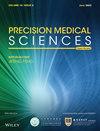Performance of full‐field digital mammography versus digital breast
IF 0.6
Q4 MEDICINE, RESEARCH & EXPERIMENTAL
引用次数: 1
Abstract
Studies have shown that the combination of digital breast tomosynthesis (DBT) and digital mammography (DM) can improve the display of malignant tumors, reduce false positive results, and make up for the major deficiencies of traditional DM. In addition, the recall rate of patients with combined DBT was significantly reduced, especially those under 50 years of age and those with dense breast glands. The objective of this study is to compare the difference of DM and DM+ DBT in the diagnosis of benign and malignant tumors in different subgroups. A retrospective analysis was performed on 578 pathologically confirmed breast diseases in Jiangsu Cancer Hospital from January 2019 to December 2021. All were female, aged 23–85, with an average age of 53. Their DM and DBT images will be reviewed in an independent blind manner by an experienced radiologist. The doctor was unable to obtain the results of previous tests. The sensitivity and specificity of population samples and different subgroups were calculated. Overall sensitivity was 65% for DM, 93% for DM+ DBT. The addition of DBT significantly increased the tumor detection rate (odds ratio, 7.05; 95% confidence interval: 4.78, 10.4; p = .00), the difference was statistically significant. For patients <50 years of age, the sensitivity of DM+ DBT (94%) was significantly higher than that of DM (54%), and for patients with breast density of 50% or more, the sensitivity of DM and DM+ DBT were 59% and 92% (p < .001). The sensitivity of DM+ DBT (92%) was significantly higher than that of DM alone (39%) in patients whose primary imaging feature was non‐mass (p < 0.001). Specificity was 77% for DM and 87% for DM+ DBT. The addition of DBT improved the specificity of DM in patients with high‐density breast and the sensitivity of DM to all subgroups. DBT has potential benefits for diagnosing of benign and malignant tumors, especially for young women with dense breasts.全场数字乳腺摄影术与数字乳房摄影术的比较
研究表明,数字化乳腺断层合成(DBT)与数字化乳房x线摄影(DM)相结合,可以改善恶性肿瘤的显示,减少假阳性结果,弥补了传统DM的主要不足。此外,DBT相结合的患者的回忆率明显降低,尤其是50岁以下和乳腺致密的患者。本研究的目的是比较不同亚组中DM和DM+ DBT对良恶性肿瘤的诊断差异。对2019年1月至2021年12月江苏省肿瘤医院578例病理确诊的乳腺疾病进行回顾性分析。所有患者均为女性,年龄在23-85岁之间,平均年龄为53岁。他们的DM和DBT图像将由经验丰富的放射科医生以独立的盲检方式进行检查。医生无法获得以前的检查结果。计算总体样本和不同亚组的敏感性和特异性。DM的总体敏感性为65%,DM+ DBT为93%。DBT的加入显著提高了肿瘤检出率(优势比,7.05;95%置信区间:4.78,10.4;P = .00),差异有统计学意义。对于<50岁的患者,DM+ DBT的敏感性(94%)明显高于DM(54%),对于乳腺密度≥50%的患者,DM和DM+ DBT的敏感性分别为59%和92% (p < 0.001)。在主要影像学特征为非肿块的患者中,DM+ DBT的敏感性(92%)显著高于DM单独(39%)(p < 0.001)。DM和DM+ DBT的特异性分别为77%和87%。DBT的加入提高了高密度乳腺患者DM的特异性和DM对所有亚组的敏感性。DBT对良性和恶性肿瘤的诊断有潜在的益处,特别是对乳房致密的年轻女性。
本文章由计算机程序翻译,如有差异,请以英文原文为准。
求助全文
约1分钟内获得全文
求助全文

 求助内容:
求助内容: 应助结果提醒方式:
应助结果提醒方式:


